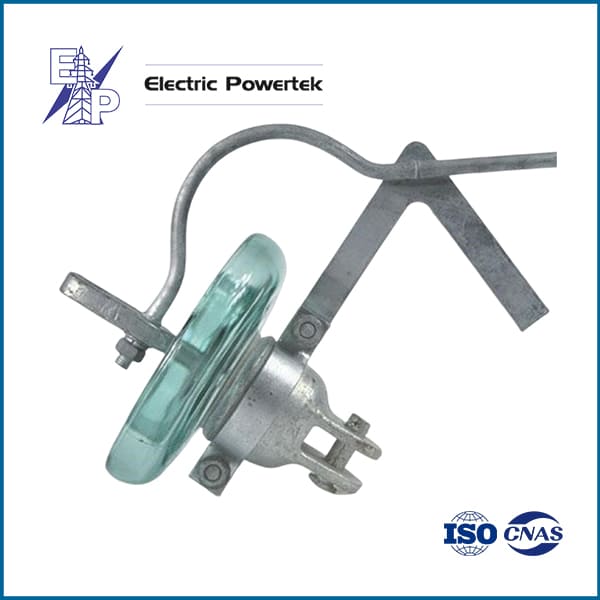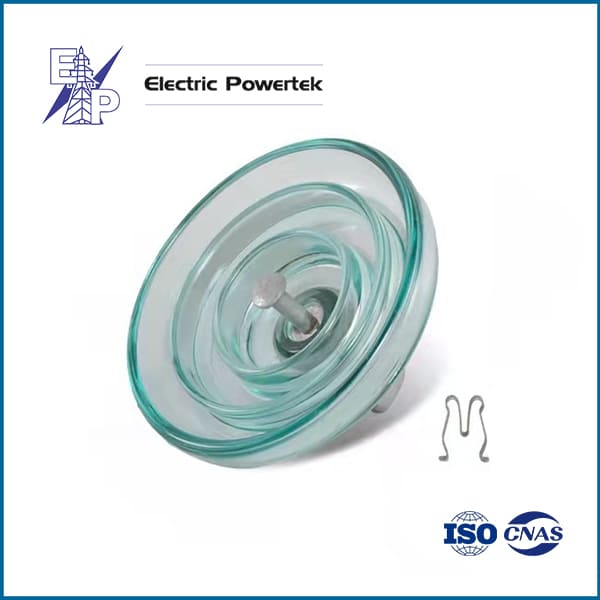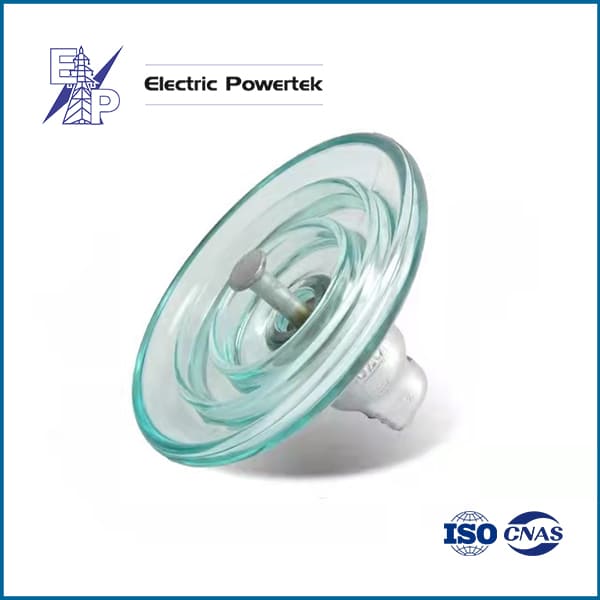Ground Wire Type Disc Suspension Toughened Glass Insulator
Glass Insulator Description

Insulators are devices used to support and insulate electrical wires. The insulator device is made of toughened glass and is called a glass insulator; Currently, toughened glass insulators are the most widely used in power lines.
|
Product name
|
Glass Insulator
|
|
Type
|
Ground wire Insulator
|
|
Material
|
Toughened glass
|
|
Scope of application
|
High Voltage
|
|
Usage
|
Ground wire protection
|
|
Application
|
Overhead transmission line
|
| Standard | IEC/ISO |
Ground wire insulators are usually installed in the ground wire protection device in the transmission line. The ground wire insulator usually consists of two parts, the insulator, and the protective gap. When the line is in normal operation, the ground wire insulator can protect the ground wire and insulate the ground wire from the iron tower. If there is an overvoltage on the ground wire, the protective gap of the ground wire insulator can realize conduction between the ground wire and the iron tower through discharge, so as to play various protective functions.
Glass Insulator Specification
| Model Number | Diameter(mm) | StructureHeight(mm) | CreepageDistance(mm) | CouplingSize
(mm) |
MechanicalFailingLoad
(kN) |
PowerFrequencyWet
Withstand Voltage (kV) |
Upper Limit Value of20mm GapPower Frequency
Discharge Voltage (kV) |
Lower Limit Value of20mm GapPower Frequency
Discharge Voltage (kV) |
15mm Gap 2500V ArcExtinguishing AbilityInductive Current(kV) | 15mm Gap 2500V ArcExtinguishing CapacityCapacitive Current(kV) | Electrode Arc Resistance(Not Less Than)Power Frequency Current(kV) | Electrode Arc Resistance(Not Less Than)Time(S) | NetWeightPerUnit(kg) | ||
| Model Number | LXDY Series | FC Series | |||||||||||||
| U70C/200 | LXDY-70C | FC70D/200 | 200 | 210 | 220 | 70 | 130 | 40 | 30 | 8 | 35 | 20 | 10 | 0.2 | 4.5 |
| U70CN/200 | LXDY-70CN | FC70CN/200 | 200 | 210 | 220 | 70 | 130 | 40 | 30 | 8 | 35 | 20 | 10 | 0.2 | 4.5 |
| U100C/200 | LXDY-100C | FC100C/200 | 200 | 210 | 220 | 100 | 130 | 40 | 30 | 8 | 35 | 20 | 10 | 0.2 | 5 |
| U70CN/200 | LXDY-100CN | FC100CN/200 | 200 | 210 | 220 | 100 | 130 | 30 | 45 | 8 | 35 | 20 | 10 | 0.2 | 4.5 |
The advantages of glass insulator
1 The raw materials used to manufacture glass insulators, in terms of their own composition, are more stable than those used to manufacture electric porcelain, creating good conditions for stabilizing the electrical and mechanical properties of glass.
2 Due to the transparency of glass, it is easy to detect small cracks and various internal defects and damages during appearance inspection.
3 The mechanical and electrical performance of tempered glass is much higher than that of porcelain, making insulators of the same type, and its size and weight are much smaller than porcelain insulators.
4 The mechanical strength of the surface layer of glass insulators is high, and the surface is not prone to cracks. The electrical strength of glass generally remains unchanged throughout the entire operation period, and its aging process is much slower than that of porcelain. Therefore, glass insulators are mainly scrapped due to self damage and occur within the first year of operation. However, defects in porcelain insulators only begin to be discovered after a few years of operation.
5 By using glass insulators, regular preventive tests on insulators during operation can be cancelled. This is because every type of damage to tempered glass can cause damage to the insulator, and operators can easily detect it during line inspections. When the insulator is damaged, the glass fragments near the steel cap and iron foot are stuck, and the mechanical strength of the remaining part of the insulator is sufficient to prevent the insulator string from breaking off.
Insulation Resistance Measurement Of Insulators
(1) The purpose of measurement is to check the insulation condition of insulators and discover defects such as insulation degradation and insulation breakdown.
(2) It is recommended to use a 5000V megohmmeter for measuring the insulation resistance of insulators on 35~220kV overhead transmission lines.
(1) The insulation resistance of newly installed insulators should be greater than or equal to 500M Ω.
(2) The insulation resistance of insulators during operation should be greater than or equal to 300M Ω.
(1) Insulators with insulation resistance less than 300M Ω and greater than 240M Ω can be considered as low value insulators.
(2) Insulators with insulation resistance less than 240M Ω can be considered as zero value insulators.
(1) Temperature has a significant impact on insulation resistance, which decreases with increasing temperature. The reason is that the temperature increases, the polarization of the insulation medium intensifies, and the increase in conductivity leads to a decrease in insulation resistance. The reason for the change is related to the degree of temperature change and the properties and structure of the insulation material.
(2) Humidity has a significant impact on surface leakage current, as it adsorbs moisture on the insulation surface, forming a water film that significantly reduces insulation resistance.
(3) Degradation caused by mechanical overload of insulators.
(4) Deterioration of moisture absorption of porcelain parts.
(5) Deterioration of internal and external stress overlap in porcelain components.
(6) Deterioration caused by thermal expansion of porcelain insulators.
(7) Deterioration of saturated expansion of steel cap pouring cement.
(8) Deterioration of freezing and expansion properties of steel cap pouring cement.
(9) Deterioration of electrical corrosion of steel caps and feet.
(10) Deterioration caused by overvoltage of insulators.
(11) Deterioration caused by internal defects in insulators.
Attention for measuring insulator resistance: When the humidity is high, the measurement should be suspended.
For single component insulators, the insulation resistance can only be measured in the event of a power outage. According to relevant regulations, a 2500V and above megohmmeter is used. The commonly used ones are 2500V and 5000V megohmmeters, as well as specialized instruments with higher voltages. But in fact, within 1 * 104M Ω, insulation resistance measured by 2500V and 5000V megohmmeters with the same accuracy at the same humidity is basically the same. When the measured insulation resistance is greater than 1 * 104M Ω, the 2500V megohmmeter cannot read the accurate insulation resistance value and can only count it as ∞. A 5000 megohmmeter can achieve a maximum insulation resistance of 2 * 105M Ω.
For insulators with multiple component combinations, the insulation resistance can be measured with power off or live. The method is to connect a high resistance to a live insulator, so that the megohmmeter for measuring insulation resistance is at ground potential, and subtract the high resistance value from the measured insulation resistance to obtain the insulation resistance value of the tested insulator. The principle wiring for measuring the insulation resistance of insulators with electricity, where R is the resistance in the high resistance pole, with a resistance value of 10-20k Ω/V and a length of 0.5-105kV/cm, and a unit resistance capacity of 1-2W; C is the grounding capacitance, which can keep the megohmmeter at ground potential. The insulation resistance of C should reach the maximum limit of the megohmmeter to ensure measurement accuracy. The capacitance of C ranges from 0.01 to 0.05 μ F. It should be able to withstand DC voltage above 3000V.
(1) The resistance of each component and suspension insulator of the pin type post insulator should not be less than 300M Ω.
(2) The insulation resistance of 500kV suspension insulators shall not be less than 500M Ω. It is worth noting that when measuring the insulation resistance of each component of a multi component post insulator, copper wire should be wound at the laminated bonding point and then connected to a megohmmeter to avoid significant differences in insulation resistance values measured at different positions, which may cause misjudgment.
Application
The ground wire is a device that protects overhead transmission lines from lightning attacks, also known as lightning protection wire. The transmission line spans a vast area, and it is easy to be struck by lightning in the thunderstorm season, which will cause interruption of power transmission, which has become one of the main reasons for power outages in the power system. Installing overhead ground wires can reduce lightning accidents and improve the safety of line operations. Ground wire insulators are usually installed in the ground wire protection device in the transmission line. The ground wire insulator usually consists of two parts, the insulator, and the protective gap.


When the line is in normal operation, the ground wire insulator can protect the ground wire and insulate the ground wire from the iron tower and can reduce the loss of power transmission energy, and open the ground wire carrier communication. If there is an overvoltage on the ground wire, the protective gap of the ground wire insulator can realize conduction between the ground wire and the iron tower through discharge, so as to play various protective functions. Among them, the anti-aging performance of tempered glass insulators for ground wires is very good. Since the dielectric constant of the glass material is between 7 and 8, the tempered glass insulators have a large main capacitance and a series of evenly distributed voltages. It is beneficial to reduce the voltage on the periphery of the insulator, and it is also beneficial to reduce radio interference and corona loss, thereby effectively prolonging the life of the glass insulator.
In addition, due to the transparency of the glass material, it is easier to find small cracks and various internal defects and damages during the shape inspection of glass insulators.
Ground wire tempered glass insulators are mainly used in overhead transmission.
















